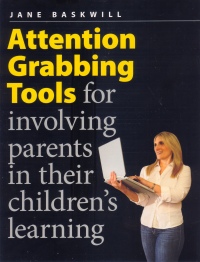| ________________
CM . . . . Volume XX Number 3 . . . . September 20, 2013
excerpt:
Research shows that when schools work together with families to support student learning, children succeed not only at school but in all aspects of their lives. Most teachers and parents would agree that a strong parent-school connection is important, but many are unsure how to initiate this relationship. In Attention Grabbing Tools for Involving Parents in Their Children's Learning, author Jane Baskwill offers many useful tips and tools on how to get an effective dialogue started. Baskwill, an associate professor in Education at Mount Saint Vincent University and a former classroom teacher, offers an authoritative voice to educators who wish to strengthen their connection with parents. It is important to note that, although the term "parent" is used throughout the book, the author is quick to acknowledge that children may belong to a variety of family groupings and that teachers should not assume that all families are the same. The author expands the definition of "parents" to include birth parents, foster parents, same-sex parents and other caregivers. This is a useful reminder for teachers who should be aware that a one-size-fits-all approach may not work when communicating with families. One of the early chapters in the book addresses the most fundamental question of most educators – how do I get started? Baskwill gives many good suggestions on how to connect with parents for the first time. She does, however, also stress the need for this initial communication to be a serious effort in order to make a good first impression. This first contact can set the tone for the rest of the school year. Chapter 3 of the book focuses on every teacher's favourite method of school-parent communication – the newsletter! Baskwill agrees that it is a favourite for a good reason. A monthly newsletter is timely and easy to produce, and it can be distributed online or in print. The author takes this favourite a step further and provides ideas on how to keep it fresh and engaging. One great suggestion is to have students create the content for the newsletters themselves. A newsletter is nice, but it does not always encourage a two-way communication between parent and school. Chapter 4 introduces some tools to open the dialogue and keep it going the whole school year. Many of Baskwill's suggestions involve the students in the discussion, thereby making it a three-way conversation. Most educators would agree that it makes perfect sense to include the student and make him/her the centre of the learning process so these communication methods will be useful. Subsequent chapters outline some ways in which teachers might engage with parents and students outside the classroom or outside of regular hours. Planning family nights or weekend activities would undoubtedly be wonderful ways to reach out to busy families, yet these ideas may prove to be too ambitious or time-consuming for many teachers. Baskwill does mention that educators should think carefully before launching into large projects as engaged and ongoing involvement is necessary for success. The chapter titled "Take Home Materials" also offers some helpful yet somewhat questionable suggestions. One such idea is book bags for parents. The author encourages teachers to pass along parenting books or books on discipline to caregivers. Although the intent is good, some parents may get offended or feel that their parenting skills are being questioned. Also, some books sent home by the teacher may run counter to the parent's own parenting philosophy. The reader should use caution and their own best judgement before rushing to try these ideas in their classroom. Overall, the format and the content of the book are quite good. Readers will appreciate the step-by-step flow of the chapters. The author gives a general introduction to the activity and then explains how to implement the activity in a straightforward, non-jargony language. Also useful are the templates/ blackline masters at the end of each chapter that can be used to carry out the suggested ideas. These ready-to-copy templates are sure to be appreciated by busy teachers. Attention Grabbing Tools for Involving Parents in Their Children's Learning is a worthwhile addition to any teacher's professional library. Recommended. Michelle Brown is a librarian in the Faculty of Education at the University of Ottawa in Ottawa, ON.
To comment
on this title or this review, send mail to cm@umanitoba.ca.
Copyright © the Manitoba Library Association. Reproduction for personal
use is permitted only if this copyright notice is maintained. Any
other reproduction is prohibited without permission.
NEXT REVIEW |
TABLE OF CONTENTS FOR THIS ISSUE
- September 20, 2013.
AUTHORS |
TITLES |
MEDIA REVIEWS |
PROFILES |
BACK ISSUES |
SEARCH |
CMARCHIVE |
HOME |
